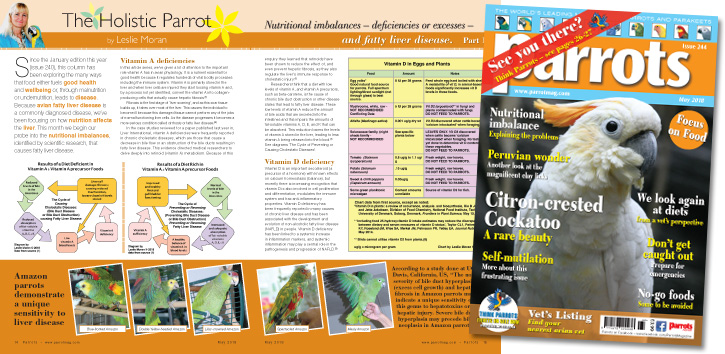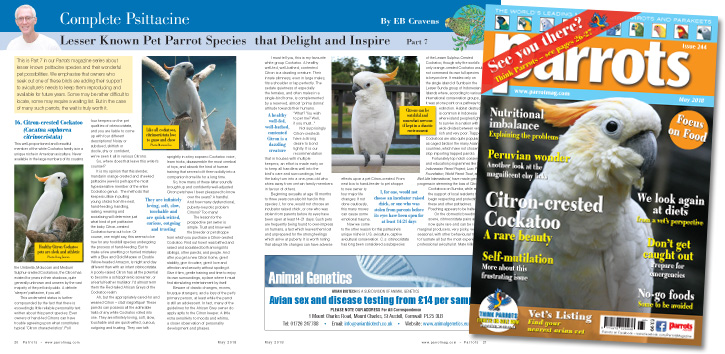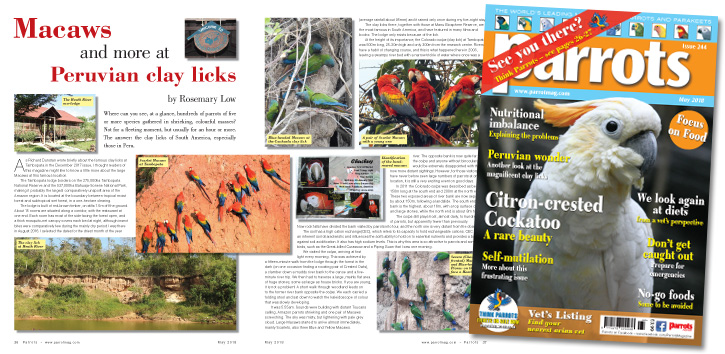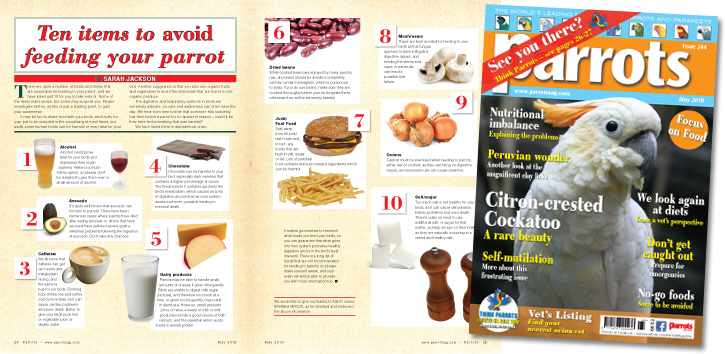
The Holistic Parrot by Leslie Moran
Since the January edition this year (issue 240), this column has been exploring the many ways that food either fuels good health and wellbeing or, through malnutrition or undernutrition, leads to disease. Because avian fatty liver disease is a commonly diagnosed disease, we’ve been focusing on how nutrition affects the liver. This month we begin our probe into the nutritional imbalances, identified by scientific research, that causes fatty liver disease.
In this article series, we’ve given a lot of attention to the important role vitamin A has in avian physiology. It is a nutrient essential for good health because it regulates hundreds of vital bodily processes including the immune system. Vitamin A is primarily stored in the liver and when liver cells are injured they start loosing vitamin A and, by a process not yet identified, convert the vitamin A into collagen-producing cells that actually cause hepatic fibrosis.
Fibrosis is the first stage of ‘liver scarring’, and as this scar tissue builds up, it takes over most of the liver. This causes the individual to become ill because this damaged tissue cannot perform any of the jobs of normal functioning liver cells. As the disease progresses it becomes a more serious condition called cirrhosis or fatty liver disease.
Buy Now!

Complete Psittacine by EB Cravens
This is Part 7 in our Parrots magazine series about lesser known psittacine species and their wonderful pet possibilities. We emphasise that owners who seek out one of these birds are adding their support to aviculture’s needs to keep them reproducing and available for future years. Some may be rather difficult to locate, some may require a waiting list. But in the case of many such parrots, the wait is truly worth it.
�Citron-crested Cockatoo (Cacatua suphurea citrinocristata)
This well-proportioned and beautiful member of the white Cockatoo family is in a unique niche in American aviculture. Never available in the large numbers of its cousins the Umbrella, Moluccan and Medium Sulphur-crested Cockatoos, the Citron has existed for years in their shadows, quite generally unknown and unseen by the vast majority of the pet bird public. A definite ‘sleeper’ psittacine, if you will.
This underrated status is further compounded by the fact that there is exceedingly little reliable personality text written about this parrot species. Even owners of hand-fed Citrons can have trouble agreeing upon what constitutes typical ‘Citron characteristics’. Poll four keepers on the pet qualities of citrinocristata, and you are liable to come up with four different descriptions! Noisy or subdued, skittish or docile, shy or confident, we've seen it all in various Citrons.
Buy Now!

by Rosemary Low
Where can you see, at a glance, hundreds of parrots of five or more species gathered in shrieking, colourful masses? Not for a fleeting moment, but usually for an hour or more. The answer: the clay licks of South America, especially those in Peru.
As Richard Dunstan wrote briefly about the famous clay licks at Tambopata in the December 2017 issue, I thought readers of this magazine might like to know a little more about the large Macaws at this famous location.
The Tambopata lodge borders on the 275,000ha Tambopata National Reserve and the 537,000ha Bahuaja-Sonene National Park, making it probably the largest comparatively unspoilt area of the Amazon region. It is located at the boundary between tropical moist forest and subtropical wet forest, in a one-hectare clearing.
Buy Now!

by Sarah Jackson
There are quite a number of foods and drinks that are unsuitable for feeding to your parrot, and we have listed just 10 for you to take note of. Some of the items make sense, but some may surprise you. Please investigate further, as this is just a starting point, to gain your awareness.
It may be fun to share food with your birds, and lovely for your pet to be included in the socialising at meal times, but sadly some human foods can be harmful or even fatal for your bird. Another suggestion is that you also use organic fruits and vegetables to avoid the chemicals that are found in non-organic produce.
The digestive and respiratory systems in birds are extremely delicate, so care and awareness can often save the day. We hear from time to time that someone has suddenly lost their beloved parrot for no apparent reason – could it be they have fed something that was harmful?
Buy Now!




